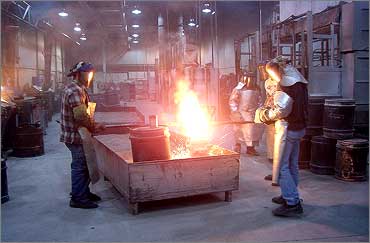Heat Treating and Cleaning
The foundry Cleaning Room is collection processes where castings are 'finished' to meet the customers specifications. A sample flow chart is shown below for one type of steel casting. This insures that castings are made and finished to the customer's specifications and standard industry practices.
When castings are removed from the shakeout, they are run through the shot blast to remove sand and expose the surface for inspection and further work. The next step is the removal of the gating system.
To pour molten metal into a mold a path is required called a 'pouring sprue'. The pouring sprue will generally have many feeders to various parts of the casting. This is called the 'gating system'.
In addition, as metal shrinks while it is cooling, so additional pockets of molten metal, called 'risers', must be present to feed into the casting. Once the pouring sprue, risers, and gates are removed in the 'Burn & Arc' areas, the castings are returned to the shot blast to be cleaned for inspection.
At the first inspection, castings are inspected for defects such as cracks, flashing, inclusions, etc. If none are found the castings are sent to the Heat Treating department. If defects are present that require welding and/or grinding the castings are sent to the appropriate area to have the defect corrected. Once rework is completed, the castings are sent to the Heat Treating department.
Heat Treating
At AGMF Casting Company castings can be heat-treated to bring about diffusion of carbon alloying elements, softening, hardenings, stress-relieving, toughening, improved machinability, increased wear resistance, and removal of hydrogen entrapped at the surface of the casting.
Steel's versatility is due to its response to thermal treatment. Heat treatment greatly increases the number of properties that can be obtained, because at certain 'critical temperatures' iron changes from one type of crystal structure to another. This structural change, known as allotropic transformation, is spontaneous and reversible and can be made to occur by simply changing the temperature of the metal.
Fundamentally, all steel heat treatments are intended to either harden or soften the metal. They involve one, or a series of operations, in which solid metal is heated and cooled under specific conditions to develop a required structure and properties. In general, the following major forms of heat treatment, for the standard steels, are used to modify properties to suit either fabrication or end use; Quenching, Tempering, Normalizing, Annealing and Stress Relieving.
To provide steel castings with the properties mention above, AGMF Casting Company has installed a modern heat-treating facility which allows the following types of heat treatments to be performed:
- Water Quenching
- Tempering
- Normalizing
- Annealing
- Stress Relieving
- Oil Quenching
- Atmospheric Carburizing
- Flame Hardening
If a casting fails the Final Inspection it may be returned for rework or sent to the scrap bin for re-melt if the defect is severe. When castings pass inspection they are sent to the shipping dock and the production department notified so that the necessary paperwork can be processed.





